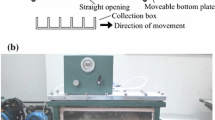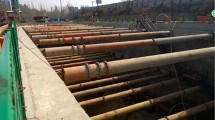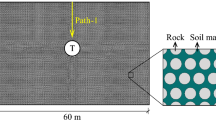Abstract
Ground subsidence caused by tunneling is becoming a common problem in China due to rapid developing of underground space. Superstructures may crack and/or incline subjected to localized ground subsidence caused by tunneling. Ground subsidence would also induce breakage of buried pipelines which may even cause ground collapse due to pipe leakage. Mechanism of ground subsidence caused by tunneling in clay has been well understood. Volume of settlement troughs in clay are widely accepted as a constant along the depth, which is equal to ground volume loss in the ground. However, ground subsidence caused by tunneling in sand is still not clear considering the change of volume of settlement trough with depth, which has been observed in practice. Therefore, mechanism of ground subsidence caused tunneling in sand deserves in-depth investigation. In this study, ground subsidence caused by tunneling in three different types of sand with relative densities of 30% (i.e., loose sand), 50% (i.e., medium-dense sand), and 70% (i.e., dense sand), were adopted in finite element (FE) modeling. All soils were modeled using Mohr-Coulomb model. Gaussian-shape displacements were applied at bottom of FE models to simulate the tunneling effect. FE modeling results demonstrate that Gaussian functions can provide a good estimation of soil settlement trough at different depth. Trough width parameter decreased with the depth, while volume of soil settlement increased with the depth. It was also found that volume of settlement trough in the loose sand was greater than those in the medium-dense sand and dense sand, which may be attributed to contraction of the medium-dense and dense sand during the settlement propagating towards the ground surface. A modified empirical equation was proposed to calculate the settlement caused by tunneling in the sand at any depth with consideration of the effect of relative density of the sand. In the proposed method, the volume change of the settlement through was also incorporated.
Access provided by CONRICYT-eBooks. Download conference paper PDF
Similar content being viewed by others
Keywords
1 Introduction
Damage of underground facilities and superstructures caused by tunneling-induced ground subsidence is becoming a common problem in China due to rapid developing of subway tunnels. For example, on October 11th 2014, huge amount of water flew into an excavation of the Metro Line #1 in Nanchang city, which caused ground collapse and formed a hole with a diameter of 23 m and a depth of 4 m. Two workers injured and buried pipelines in the range of ground collapse were broken. Characteristics of ground subsidence caused by the tunneling have attracted wide research attention [1,2,3]. According to [4], Gaussian function can be employed to fit settlement trough at ground surface induced by tunneling. Gaussian function has been used successfully in the previous studies [5,6,7,8]. Mair et al. [7] investigated mechanism of settlement propagation caused by tunneling in clay based on their centrifuge tests results. They reported that volume of settlement troughs in clay could be treated as a constant along the depth, which is equal to the volume of ground loss in the ground. They also proposed an empirical method to predict the subsurface settlement at a given depth. Wang et al. [9] proposed a modified method for estimating the subsurface settlement caused by tunneling in sand with consideration of volume change of settlement trough based on lab-scale physical model tests. However, the relative density was not taken into account in Wang et al.’s method, which is essential for granular material and may influence the settlement propagation mechanism.
In this study, finite element (FE) modeling was conducted to investigate the effect of sand relative density on the mechanism of settlement propagation caused by tunneling in sand. Three different types of sand, namely, loose, medium-dense, and dense sand were used as the surrounding soil of tunnel, which was simulated using Mohr-Coulomb model. Gaussian-shape displacements were applied at the bottom of FE models to simulate tunneling effect. Finally, characteristics of subsurface settlement and ground subsidence were analyzed and a modified method was proposed to predict subsurface settlement caused by tunneling in sand.
2 Numerical Modeling
Finite element program ABAQUS® was employed for the numerical modeling in this study. Considering the symmetry of the numerical model, only half was calculated as shown in Fig. 1. Vertical boundaries were restrained against displacements in the horizontal direction. A Gaussian distribution displacement was applied at the bottom of the numerical model expressed as Eq. (1), where Smax and i were set as 0.3 and 2 m, respectively. Vertical displacements at upper boundary (i.e., the ground surface) were set as free.
where Smax is maximum soil settlement (m); is is trough width parameter corresponding to distance from centerline of soil settlement trough to the point of inflection (m); and x is distance from the interested point to the centerline of ground subsidence zone (m).
Three different soils, namely, loose sand, medium sand, and dense sand, were used in the FE modeling. Elastic perfect plastic responses of soil to tunneling were characterized by using the Mohr-Coulomb failure criterion. Properties of soils in the numerical model were adopted from Balkaya and Moore (2013), as tabulated in Table 1. Soil materials were modeled as isotropic solids, employing C3D20 type twenty nodded (quadratic) brick elements. A finer FE mesh was used near the symmetric plan of the model, as shown in Fig. 2. The groundwater effect on the tunneling-induced ground subsidence was not considered in this study.
3 Numerical Results Analysis
Figure 3 shows the variation of soil settlements obtained from FE models at selected depths of 0, 1.05, and 2.1 m for three cases. It is seen that the soil settlements increase with an increase of depth from the ground surface, which presents as Gaussian curves. Equation (1) was therefore employed to characterize the soil settlement troughs with values of coefficient of determination, R2, greater than 0.95. The maximum settlement at a given depth decreased with an increase of the relative density.
Figure 4 shows the variation of trough width parameter (is) with the depth. It is seen that the is values increased with decrease of the depth. Width of settlement trough in sand can be calculated by the following expression (Wang et al. [9]),
where Z0 is depth of the tunnel axis (m); Z is depth of the calculated settlement from ground surface (m).
Figure 5 shows the relationship between normalized width of settlement trough of the sand (is′) obtained in this study by that calculated one by Eq. (2) (is′′) and normalized relative density of the sand (Dr) in this study by that in Wang et al. [9] (i.e., 62%). The relationship between is/is′ and Dr/0.62 was expressed as follows:
Volume of soil settlement trough (denoted as V s ) was calculated by the following equation (Vorster [3]):
where all parameters and their units were defined in Eq. (1).
Figure 6 shows the variation of volume of soil settlement trough (V s ) with the depth (Z). It is seen that the Vs values increased with an increase of Z with an order of VLoose sand > VMedium sand > VDense sand. Volume of the settlement trough of the sand can be also determined by (Wang et al. [9]),
where VL is volume of ground loss per unit length in tunnel (m3/m); other parameters and their units were defined in Eq. (2).
Figure 7 shows the relationship between normalized volume of settlement trough of the sand (Vs′) obtained in this study by the calculated one using Eq. (5) (Vs′′) and normalized relative density of the sand (Dr) in this study by that in Wang et al. (2016) (i.e., 62%). A linear equation was derived using the least-square-root method to quantify the relationship between Vs/Vs′ and Dr/0.62, as expressed by the following equation:
Substituting Eq. (2) through (6) into Eq. (1) can be used to calculate settlement caused by tunneling in sand with considering the effect of relative density of the sand:
4 Conclusions
Finite element modeling was conducted to investigate the characteristics of soil settlement trough caused by tunneling in sand. Three different types of sand, loose (D r = 30%), medium (D r = 50%), and dense sand (D r = 70%), were used in this study. Gaussian function displacements were applied at the model bottom to simulate the tunneling effect. Based on the numerical results in this study, the following conclusions can be drawn:
-
(1)
Maximum soil settlements caused by tunneling increased with an increase of the depth. Surface and subsurface settlement troughs are all fit for Gaussian curves.
-
(2)
Trough width parameter increased with a decrease of the depth, while volume of soil settlement decreased with a decrease of the depth.
-
(3)
Values of volume of settlement trough at a given depth increased with a decrease of the relative density of sand.
-
(4)
A modified equation was proposed to calculate the settlement caused by tunneling in the sand at any depth with consideration of the effect of sand relative density on the settlement propagation mechanism.
References
Attewell, P.B., Yeates, J., Selby, A.R.: Soil Movements Induced by Tunneling and their Effects on Pipelines and Structures. Blackie and Son Ltd., London (1986)
Klar, A., Marshall, A.M.: Shell versus beam representation of pipes in the evaluation of tunneling effects on pipelines. Tunn. Undergr. Space Technol. 23(4), 431–437 (2008)
Vorster, T.E.B.: The effects of tunnelling on buried pipes. Ph.D. thesis, Cambridge University, Cambridge, UK (2005)
Peck, B.: Deep excavations and tunneling in soft ground. In: Proceedings of 7th International Conference on Soil Mechanics and Foundation Engineering, Mexico city, pp. 225–290 (1969)
O’Reilly, M.P., New, B.M.: Settlement above tunnels in the United Kingdom – their magnitude and prediction. In: Tunnelling 1982, Proceedings of the Third International Symposium, pp. 173–18. Institution of Mining and Metallurgy, London (1982)
New, B.M., O’Reilly, M.P.: Tunneling induced ground movements: predicting their magnitudes and effects. In: Proceedings of the 4th International Conference on Ground Movements and Structures, pp. 671–697. Pentech Press, London (1991)
Mair, R.J., Taylor, R.N., Bracegirdle, A.: Subsurface settlement profiles above tunnels in clays. Géotechnique 43(2), 315–320 (1993)
New, B.M., Bowers, K.H.: Ground movement model validation at the Heathrow Express trial tunnel. In: Tunnelling 1994, Proceedings of the 7th International Symposium, pp. 301–329. Chapman & Hall, London (1994)
Wang, F., Miao, L., Yang, X., Du, Y.J., Liang, F.Y.: The volume of settlement trough change with depth caused by tunneling in sands. KSCE J. Civil Eng. 20(7), 2719–2724 (2016)
Author information
Authors and Affiliations
Corresponding author
Editor information
Editors and Affiliations
Rights and permissions
Copyright information
© 2018 Springer Nature Singapore Pte Ltd.
About this paper
Cite this paper
Zhou, M., Wang, F., Du, YJ. (2018). Numerical Modeling on Localized Ground Subsidence Induced by the Tunneling in Sand. In: Zhang, D., Huang, X. (eds) Proceedings of GeoShanghai 2018 International Conference: Tunnelling and Underground Construction. GSIC 2018. Springer, Singapore. https://doi.org/10.1007/978-981-13-0017-2_8
Download citation
DOI: https://doi.org/10.1007/978-981-13-0017-2_8
Published:
Publisher Name: Springer, Singapore
Print ISBN: 978-981-13-0016-5
Online ISBN: 978-981-13-0017-2
eBook Packages: Earth and Environmental ScienceEarth and Environmental Science (R0)











